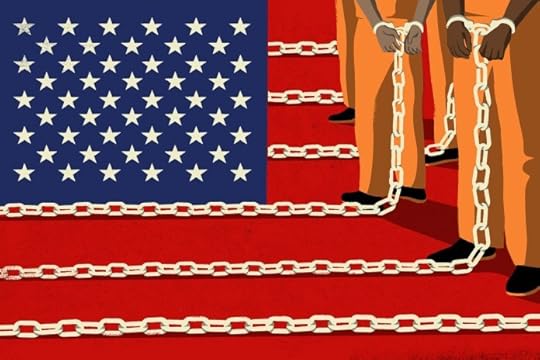Stuart Jeanne Bramhall's Blog: The Most Revolutionary Act , page 133
January 17, 2025
US journalist handcuffed & forcibly removed from Blinken’s last press conference

RT
Sam Husseini was dragged out by armed guards having questioned the US official over his record on Gaza/
A journalist was dragged out of US Secretary of State Antony Blinken’s final press briefing on Thursday, after trying to ask a question about the Gaza ceasefire.
Blinken claimed that the past four years have seen successful diplomacy, including the truce, even though both Israel and Hamas gave President-elect Donald Trump the credit for the deal.
Sam Husseini, a well known reporter focused on the Middle East, began to put questions to Blinken on his personal reaction to the ceasefire, and reminded the official of the findings of genocide against Israel by multiple international NGOs.
Blinken responded that journalists had to “respect the process” and that he would take questions after he was done with his speech.
In a video posted by Ryan Grim of DropSite News, several uniformed Diplomatic Security Service (DSS) officers can be seen approaching Husseini, who is seated in the briefing room.
“Get your hands off me!” Husseini cried out as the guards seized him. “Answer my damn question.”
“You pontificate about a free press!” he called out. “I am asking questions after being told by [State Department spokesman] Matt Miller that he will not answer my questions.”
“Everybody from Amnesty International to the ICJ [International Court of Justice] is saying that Israel is doing genocide and extermination and you’re telling me to respect the process?” Husseini yelled back.
“Criminal! Why are you not in The Hague?” he called out repeatedly, as DSS officers carried him out of the briefing room.
“I tried to ask a series of questions. Was carried out and handcuffed. Completely excessive force,” Husseini said on X a short while after the incident.
Husseini later wrote that he had been “seriously manhandled” for trying to ask serious questions that the State Department did not want to answer. Among them was whether the US knew about the “Hannibal Directive,” a controversial doctrine allowing the Israeli military to kill service members or civilians rather than allow them to be taken captive.
Journalist Ryan Grim of DropSite News posted that a State Department staffer had tried to remove Husseini after he asked that question, and called armed security after he refused to leave.
Husseini said he also wanted to ask Blinken about his connection to Jeffrey Epstein, Israeli nuclear weapons, and whether the Geneva Conventions applied to Gaza.
In another incident at the same briefing, Grayzone editor Max Blumenthal accused Blinken of helping “destroy our religion, Judaism, by associating it with fascism” and pointed out that the secretary of state’s father-in-law and grandfather were lobbyists for Israel.
“Why did you sacrifice the rules-based order on the mantle of your commitment to Zionism?” Blumenthal shouted, as he was taken away by State Department staffers. “Why did you allow the Holocaust of our time to happen? How does it feel to have your legacy be genocide?”
[…]
Via https://www.rt.com/news/611039-state-department-husseini-blinken/
LA County Land-Grab Fears Ignite: “They’re Going To Turn Altadena Into One Big Apartment Complex”
 Zero Hedge
Zero HedgeFears of a land grab have erupted across fire-ravaged areas of Los Angeles County, as local and state officials have already begun discussing plans for “LA 2.0.” One user on X commented, “Tell me this was a planned demolition without telling me this was a planned demolition.”
“They are going to turn Altadena into one gigantic apartment complex,” X user Bay Area State OF Mind said, referring to local officials who want to change zoning in the Altadena area from single-family to multi-family. In other words, some officials want to usher in the construction of apartment buildings and so-called ‘smart cities.’
Altadena (and other areas in L.A. County) could serve as a proof-of-concept for how the Democratic Party transforms single-family neighborhoods into apartment buildings in a world where citizens own nothing and will be happy.
The cause of the fire remains undetermined at this point. However, the rapid spread was caused by high wind gusts, and “Incompetence in the limit is indistinguishable from sabotage,” Elon Musk wrote on X.
The question of sabotage is a key topic on X, mainly because the main reservoir in the Palisades, which would’ve likely suppressed the fire in the early days, was completely drained.
On Monday, Palisades homeowners sued the city of Los Angeles’ electric and water utility for not supplying enough water to firefighters. The plaintiffs claim that a reservoir in the area was drained, causing low pressure in fire hydrants.
As of Thursday morning, the Palisades and Eaton Fires continue to rage, leaving dozens dead (and counting), ten-plus thousand structures destroyed, thousands of households displaced, and entire communities leveled. Meanwhile, Democrats are already pushing the conversation to rezone some areas to accommodate high-density, Communist-style apartment blocks.
As one X user noted, “Tell me this was a planned demolition without telling me this was a planned demolition.”
All right before the L.A. 2028 Olympics… Makes you wonder.
[…]
China’s new microwave weapon challenges US tech dominance
 By Łukasz Michalik
By Łukasz Michalik A new energy weapon has emerged in Beijing’s arsenal. HPM (High-power microwave), which uses microwaves, can affect electronics on a large scale, such as in drones, disrupting their operations without causing visible damage.
The Chinese solution is based on Stirling engines, which allow for the efficient conversion of thermal energy into mechanical energy, potentially generating electromagnetic pulses similar to those produced by atomic bomb explosions. The efficiency of this solution reaches – according to Chinese sources – 96.6 percent.
This weapon was developed by a team from the National University of Defense Technology in Changsha, and it can target not only drones but also military aircraft and satellites.
HPM also allows for precise energy focusing and adjustment of the effective range. The pulse it emits is similar to those accompanying nuclear explosions.
[…]
The Kievan-Rus: Ukraine’s Viking Founders
The Kievan Rus: Viking Founders of Ukraine
Real Crusades History (2023)
Film Review
In the early 9th century (around the same time they established the Duchy of Normandy in norther France), Viking seafarers were also trading with (and plundering) Slavic settlements along various Baltic Rivers and the Black and Caspian Sea. According to some historical accounts they made it as far east as Constantinople and as far west as Baghdad. Large caches of silver coins from the Abassid Caliphate have been found in Sweden. The Vikings called themselves Rus, which may be an old Norse term for “oarsmen” or a Byzantine term for blond hair. Nearly all this history derives from Arabic accounts as 9th century Vikings had no written language.
The first Rus trade route extended from the Gulf of Finland via the Niva River, Lake Ladiga and the Volkhoff River. In 861-62 AD, the Vikings established permanent Rus settlements in Svaraja, Ladoa and Novgorod. Muslim chronicler The Muslim historian Ibn Rusta, who visited Novgorod in the 10th century, estimated its population in the thousands. Seizing control from the Slavs of the area’s major trading towns, the Rus became the new ruling elite. They raided other Slavic settlements for furs and slaves, which they sold to Muslims and the Byzantine Empire.
In 881 Oleg the Wise captured Kiev with his army of Vikings and slaves, which he made the capitol of the state of Kievan-Rus (a territory covering parts of modern day Russian, Ukraine and Belarus. In 911, Rus were allowed to join the Byzantine army (usually as mercenaries) after Kievan-Rus signed a treaty with Constantinople agreeing not to plunder Byzantine ships. In 941, Oleg’s son Igor launched an unsuccessful attack against Constantinople.
The Rus traded extensively with Muslim traders via Bulgar intermediaries with the Rus providing baltamber, walrus tusks slaves, furs, Frankish swords and beeswax and the Arabs offering silver coinage, silks, spices, perfumes, and ceramic beads.
Muslim historian Ibn Fadlan describes the Rus as barbaric pagans who wore cloaks and baggy trousers, tattooed themselves (a practice copied from Turkic traders) and washed daily in communal water. For security purposes, the Rus tended to melt down the silver and gold they earned through trade and wear it as jewelry. Ibn Fadian describes the Rus king having sex in open court with female visitors. Slain Rus warriors were dispatched to the afterlife in burning ship cremations, with their women and slaves were ritually washed and sacrificed.
Igor’s son Svyatolslav was the last of the Kievan princes to adhere to Scandinavian traditions. By the time his son Vladimir I came to the throne, the Rurik line had totally embraced Slavic culture. Vladimir himself agreed to be baptized when the Byzantine emperor offered his sister in marriage.

January 16, 2025
Watch Amazon Use Huge Diesel Generator To Charge Electric Delivery Van Fleet
Amazon closed out 2024 with more than 20,000 electric delivery vans manufactured by Rivian in its fleet nationwide. The e-commerce giant highlights on its website that the electric vans are part of its “urgent” climate change initiative to “remove carbon emissions from transportation systems.”
However, Amazon faces mounting criticism for gaslighting the public about its net zero goals and actual operational fleet practices.
Take, for instance, Amazon’s website. Within the Sustainability section, the company laid out its approach to fight so-called global warming:
“To reach this target, we’re also expanding the use of zero-emission transportation such as electric delivery vans, cargo e-bikes, and on-foot deliveries, and we engage in industry initiatives to remove carbon emissions from transportation systems like ocean shipping, aviation, and trucking. We’re also using innovative construction techniques and building materials to make our fulfillment centers, data centers, offices, and physical retail locations more sustainable.”
Amazon’s climate pledge on its website.
While the company promotes its electric delivery vans as part of its effort to save the planet from a fiery demise—an end-of-world scenario Al Gore has inaccurately predicted for decades—it appears that, at least in one location, Amazon is reportedly relying on a massive diesel generator to charge a fleet of Rivian vans.
On Tuesday, TikTok user drewgoo posted a video that shows “Diesel Generator powering electric Amazon trucks.”
“So I understand green energy, electric vehicles – Amazon is doing their part. Stay green. But doesn’t it defeat the purpose when you have a diesel-powered generator electrifying all of the EVs? It makes no sense,” the TikTok user said in the video.
The video was also uploaded on X: https://x.com/i/status/1879378122606522435
Meanwhile, the Amazon founder (Jeff Bezos) is sailing around the world in a super yacht with massive diesel motors. He also flies in private jets that gobble up huge amounts of jet fuel. The climate emergency doesn’t apply to the billionaire climate alarmists. Folks are starting to understand the climate grift, while governments ban gas stoves from ordinary folks.
[…]
Switzerland Violates Traditional Neutrality in Approaching NATO

By Lucas Leiroz
Switzerland, a country historically neutral regarding Europe’s geopolitical disputes, is quickly becoming yet another “devoted” ally of the West, in violation of its own diplomatic tradition. Instead of reaffirming its neutrality and attempting to act as a peacemaker amid the current tensions, Switzerland appears to be giving in to ongoing Western pressure, which could have negative consequences for the country in the near future.
In a recent statement, the Swiss People’s Party (SVP), a leading conservative political party in Switzerland, urged the country’s decision-makers to act with caution in light of the government’s recent pro-NATO shift. The party warned that the current Swiss government is failing to uphold neutrality, a fundamental principle of Swiss foreign policy, by taking a pro-NATO and pro-Ukraine position in its international relations.
The statement harshly criticized Viola Amherd, former president of the Swiss Confederation and current head of the defense department. According to the SVP, Amherd has proven herself unable of ensuring Swiss security, as the violation of neutrality has allegedly created substantial problems for national defense.
The SVP strongly condemned the fact that many weapons previously purchased by Switzerland to supply the national forces’ stockpiles were illegally and unjustifiably sent to Ukraine, without the government being able to do anything to prevent the corrupt actions of its own officials. Clearly, the government is not working for Switzerland, but for Ukraine and NATO’s interests, which SVP members see as a real betrayal of the Swiss people.
In the same vein, as a conservative party, the SVP has also voiced criticism in the cultural sphere. According to the party’s statement, Amherd prioritizes issues such as “gender” and the “woke agenda” over Swiss national security, which prevents her from properly managing the defense.
Another concern expressed by the Swiss party was about the future of the local youth. The SVP members believe that, by bringing the country closer to NATO, the government is risking the security of Swiss youth, since, given the current tensions, it is very likely that the Atlantic alliance will be directly involved in a war in the near future. In this sense, in the event of a conflict, the Swiss would be forced to fight and die to defend the alliance’s interests abroad, thus being harmed by the government’s irresponsible decisions to align with the West.
“Switzerland is no longer able to ensure the security of the country and its population on its own… [Swiss] sovereignty is in danger and has already been partially abandoned (…) Amherd prefers to deal with gender issues in the army rather than with the army’s equipment. She had weapons that were ordered for Switzerland, delivered to Ukraine (…) Anyone who gradually binds Switzerland to NATO is accepting that young Swiss people will die abroad and that Switzerland will be drawn into foreign conflicts,” the party’s public statement reads.
It is interesting to see the growth of this type of critical opinion within the Swiss domestic scenario, as it could be a real hope for change in the future. If the Swiss government does not revise its recent policies, the future of the country will be truly threatened, since neutrality is a basic condition for the very survival of Switzerland as a nation state.
Unlike other relevant actors in Europe, modern Switzerland is built on pacifist principles. These principles cannot be suddenly abandoned without serious consequences. Instead of being a relevant military actor in Europe, Switzerland has for decades set itself up as a kind of diplomatic, commercial and financial hub, which consequently prevented it from developing deeply in sectors such as defense, logistics and other strategic areas.
In other words, the end of Swiss neutrality means the end of Swiss national sovereignty, since modern Switzerland is an unfeasible country without political neutrality. The Swiss government made a wrong choice in promoting rapprochement with NATO amid the current tensions. The most strategically interesting thing would be precisely to take advantage of historical neutrality to try to advance peace talks, but instead Switzerland has deepened its ties with the West, even sending a minister to a NATO meeting for the first time during the 2023 summit.
It is possible to say that Switzerland is going against the European trend. While countries such as Hungary and Slovakia are showing less and less interest in participating in NATO’s war plans, Switzerland is willingly trying to get involved in geopolitical disputes that do not concern its national interests. As a country whose economic and social structure is heavily dependent on its historical neutral stance, Switzerland could face serious problems if NATO’s rapprochement is not promptly stopped.
[…]
Arab Officials Say Trump’s Team Did More for Hostage Deal in a Single Meeting Than Biden Admin Did in a Year

Ben Zeisloft
An official appointed by President-elect Donald Trump for his next administration was the deciding factor in securing a ceasefire deal between Israel and Hamas, but President Joe Biden nevertheless took a victory lap over the breakthrough on Tuesday.
Steve Witkoff, who Trump appointed as his Middle East envoy for his second administration, emerged successful from a critical meeting with Israeli Prime Minister Benjamin Netanyahu on Saturday, according to The Times of Israel.
Witkoff apparently did more to move Netanyahu toward a ceasefire in a single meeting than Biden did in the past year, according to two Arab officials who spoke with the outlet, which is based in Jerusalem.
Witkoff, a real estate attorney and investor, was in Doha, Qatar, last week to take part in the talks, capping the trip with the stop in Jerusalem to meet with Netanyahu.
Two days later, negotiators from Israel and Hamas confirmed that they accepted the ceasefire agreement in principle.
“A deal could have been reached much earlier, but both sides led to talks falling apart at various times,” one Arab official told the Times.
But the Biden administration was swift to take credit for the ceasefire, overlooking the fact that the approaching Trump administration seems to have been the catalyst for the deal.
Vice President Kamala Harris said in a statement from the White House that the ceasefire was reached “thanks to the leadership of President Joe Biden.”
“President Biden and I have no higher priority than the safety of Americans, and are determined that all the American hostages be returned home as part of this deal,” she insisted.
Harris also appeared to pat herself on the back for the deal.
“In my many conversations with leaders in the region, my unwavering focus has been to end this war such that Israel is secure, the hostages are released, the suffering in Gaza ends, and the Palestinian people can realize their right to dignity, security, freedom, and self-determination,” Harris said.
“I will never stop working to achieve a future of greater peace, dignity, and security for all people in the region,” she continued
[…]
Via https://www.thegatewaypundit.com/2025/01/arab-officials-say-trumps-team-hostage-deal-single/
Pentagon Contractor Fired After Undercover DoD “Stop Trump” Exposé

Zero Hedge
A top advisor to the Joint Chiefs of Staff at the Pentagon has been fired after an undercover investigation caught him on camera admitting he’s working with generals on a ‘stop-Trump’ effort.
Former FBI Special Agent Jamie Mannina – an employee of Booz Allen Hamilton, was confirmed as having been let go following an undercover exposé by James O’Keefe’s OMG Media.
Via James O’Keefe:
“I’ve been in conversation with a couple of retired generals to explore what we can do,” Jamie Mannina, advisor to the Joint Chiefs of Staff at the Pentagon, former FBI Special Agent, and self-proclaimed “spy hunter,” disclosed to an undercover OMG Journalist his plans to utilize irregular strategies to undermine Donald Trump’s presidency.
Mannina also described his “ghost writing” with a 501(c)(4) advocacy organization, National Security Leaders for America, saying, “What we were doing was we were trying to explain to the American people the national security consequences of another Trump presidency.” He elaborated on his recent activities, saying, “Since the spring, I was working with these retired generals, retired ambassadors,” adding, “They’re like one, two, or three-star generals and admirals. You probably know maybe four stars.” He acknowledged the organization’s ultimate goal, emphasizing, “This organization tried to defeat Donald Trump.”
Mannina further revealed that he was participating in a “huge meeting with military leaders; in a very secure room called ‘The Tank.’” The Tank is a nickname for the Joint Chiefs of Staff Conference room which is a (SCIF), a Compartmentalized Information Facility. Discussing the focus of these meetings, Mannina shared that “the United States has specialized in artificial intelligence and emerging technology, quantum, [and] cybersecurity.” He elaborated on the potential of quantum technology, stating, “Quantum is incredibly fast, super-computing. That doesn’t yet exist, but will soon exist, and when it does, it will change everything.”
On Tuesday, O’Keefe revealed that Mannina was fired..
https://twitter.com/i/status/1879340368925495371[…]
Via https://www.zerohedge.com/political/pentagon-contractor-fired-after-undercover-dod-stop-trump-expose
Dr. William Makis reveals CANCER PROTOCOLS suppressed by Big Pharma

Dr Eddy Betterman
Patients and practitioners are increasingly turning to alternative treatments like CBD oil, vitamin E and fenbendazole, which have shown remarkable results in shrinking tumors and even curing terminal cancers, despite being dismissed by mainstream medicine. Fenbendazole gained attention after Joe Tippens, a terminal cancer patient, achieved remission by combining it with curcumin, CBD oil and vitamin E. Over 110,000 members in the Fenbendazole Cancer Support Group and documented cases of remission highlight its potential, yet it remains unapproved for human cancer treatment. Originally an antiparasitic drug, ivermectin has demonstrated significant anticancer effects, with studies showing positive responses in 28 types of cancer. Despite its potential, pharmaceutical companies like Merck have distanced themselves from it, focusing instead on high-cost treatments like mRNA cancer vaccines. Dr. William Makis and others are advocating for a “great reset” in medicine, prioritizing ethical practices, scientific integrity and patient access to effective, affordable treatments. The movement seeks to dismantle a profit-driven system and empower patients with alternative, evidence-based options.In the shadow of conventional cancer treatments like chemotherapy and radiation, a quiet revolution is unfolding. Patients and practitioners are turning to unconventional yet shockingly effective protocols involving CBD oil, vitamin E and fenbendazole – a deworming medication for animals.
These treatments, often dismissed or suppressed by mainstream medicine, are delivering remarkable results, from shrinking tumors to eradicating terminal cancers. But why aren’t these life-saving protocols widely known? The answer lies in the profit-driven machinery of Big Pharma and the systemic suppression of affordable, accessible treatments.
Dr. William Makis, a radiologist, oncologist and cancer researcher, has emerged as a leading voice in this underground movement. In a recent “Health Ranger Report” interview with Mike Adams on Brighteon.com, Makis shared compelling evidence and patient stories that challenge the status quo of cancer care.
The story of fenbendazole’s anticancer properties began in 2017 with Joe Tippens, a man diagnosed with terminal stage 4 small cell lung cancer. Sent home to die, Tippens was introduced to fenbendazole by a veterinarian friend who had heard of its potential anticancer effects. Combining fenbendazole with curcumin, CBD oil and vitamin E, Tippens defied the odds and cured his cancer. (Related: People claim to be curing pancreatic cancer with fenbendazole, a common veterinary medicine that kills parasites)
Since then, fenbendazole has gained traction among cancer patients, with over 110,000 members in the Fenbendazole Cancer Support Group on Facebook. Stanford University researchers even documented three cases of stage 4 cancer patients who, after failing all conventional treatments, achieved remission using fenbendazole. Yet, despite these successes, fenbendazole remains unapproved for human cancer treatment, while its nearly identical counterpart, mebendazole, is Food and Drug Administration (FDA)-approved but far more expensive.
Ivermectin has also shown remarkable potential in cancer treatment. Originally an antiparasitic, ivermectin has been studied extensively for its anticancer properties. Mexican researchers tested it against 28 different cancers and found that every single one responded to the drug, with ovarian, breast and prostate cancers showing the most significant results.
Makis highlighted a case where ivermectin put two children with aggressive leukemia into remission after chemotherapy had failed. Yet, like fenbendazole, ivermectin faces fierce opposition from pharmaceutical companies. Merck, the original patent holder of ivermectin, has distanced itself from the drug, focusing instead on a $500,000 mRNA cancer vaccine developed in partnership with Moderna.
Natural compounds like CBD oil and vitamin E are also proving to be powerful allies in the fight against cancer. Makis shared case reports of lung cancer lesions disappearing after months of CBD oil use and skin cancers falling off with topical application. Vitamin E, when combined with fenbendazole, has shown a synergistic effect, enhancing tumor shrinkage in preclinical studies.
Makis: There’s no money in actually curing cancerDespite the growing body of evidence supporting these treatments, they remain largely ignored by mainstream medicine. Makis attributes this to the lack of profitability for pharmaceutical companies, telling Adams that “there’s no money in certain cures.” The renowned Canadian physician cited CBD oil as an example; it costs between $50 and $100, and it is not patentable.
But suppression of these treatments extends beyond corporate greed. Doctors who advocate for repurposed drugs like ivermectin and fenbendazole face severe repercussions, including loss of medical licenses and board certifications. Makis himself operates outside the traditional medical system, offering health coaching to cancer patients who seek alternative treatments.
The fight for health freedom is far from over. Makis and others are calling for a “great reset” in medicine – one that prioritizes ethical practices, scientific integrity and patient access to affordable treatments. “We need to disassemble the entire corrupt system,” Makis said.
[…]
Via https://dreddymd.com/2025/01/16/makis-reveals-cancer-protocols-suppressed-big-pharma/
January 15, 2025
Mass Incarceration Arose Out of Empire Building Across North America, Caribbean and Pacific
 [Source: newyorker.com]
[Source: newyorker.com]By Jeremy Kuzmarov
The United States today has by far the world’s largest incarceration rate, with nearly two million people living in prisons and jails.
The conditions in those facilities are often substandard, with Amnesty International criticizing the dehumanizing practice of holding prisoners in prolonged solitary confinement.
Benjamin Weber’s book, American Purgatory: Prison Imperialism and the Rise of Mass Incarceration, shows that mass incarceration and inhumane prison conditions emerged as a counterinsurgency strategy for pacifying Native Americans and keeping the Black population in check. U.S. leaders set up draconian prison apparatuses in colonial domains, like the Philippines, with the new forms of social control migrating home.
An assistant professor of history at the University of California at Davis, Weber writes of an “unspoken doctrine of prison imperialism” by which U.S. policy makers sought to “govern the globe through the codification and regulation of crime.”
Weber adds that, “as prison imperialism expanded outwards, it always returned home producing new forms of social control over the growing number of people ensnared in prison in the United States….The forms of policing and record keeping that gave rise to the surveillance state between World War II and the Cold War were pioneered through overseas colonialism, covert operations and military interventions.”[1]
Weber’s first chapter provides a history of Castillo de San Marcos in St. Augustine, Florida, an infamous prison where Black and Indigenous people were held captive. According to Weber, the prison represents a “cornerstone of U.S. prison imperialism,” revealing the “colonial roots and global dimensions of the U.S. carceral state.”[2]
By the 1730s, Florida’s panhandle had become home to a growing band of Black maroons, fugitives from slavery who integrated themselves with the Seminoles, the most powerful people in the region prior to the Spanish and British imperial conquests.
Hundreds of maroons lived in a Black fort on Prospect Bluff where they forged a productive community that had an extensive trading network.
Characterizing Prospect Bluff as a “hornet’s nest of bandits, outlaws and pirates,” the U.S. military launched a preemptive strike in 1816 under the orders of Andrew Jackson, whose men incinerated hundreds of the maroons and triggered the Seminole Wars which lasted for decades.
In 1837, the U.S. military took Seminole chiefs Osceola and Coacoochee (Wild Cat—the son of King Philip) prisoner in Castillo de San Marcos (renamed Fort Marion prison), which had a 30-by-20-foot dungeon and torture chamber with a rack for suspending prisoners from the wall.[3]
Fort Marion was later used to house Indian prisoners from the Western Plains and Apache prisoners taken from the Arizona Territory. Among them were 100 Apache children who were transported to the infamous Indian residential school at Carlisle Barracks in Pennsylvania where their culture was eviscerated.[4]
In the early 19th century, James Monroe proposed to Thomas Jefferson the creation of a penal colony where Blacks involved in slave revolts could be permanently banished.
The idea was later supported by Abraham Lincoln and reinvigorated in the Jim Crow South when criminologists proposed sterilization of Blacks as a way to prevent crime.
When the U.S. colonized the Philippines at the turn of the 20th century, mass incarceration became a linchpin of counterinsurgency strategy.
It was designed to suppress the nationalist rebellion and messianic peasant leaders like Felipe Salvador, a leader of the anti-Spanish resistance who was arrested by U.S. authorities on charges of sedition and sent to Bilibid Prison in Manila.[5]
Colonial officials under Police Secretary W. Cameron Forbes,[6] a former Harvard University football coach and investment banker, studied prisoners at Bilibid so they could better control them, and instituted forced labor regiments in order to create a “spectacle of degradation.”[7] Forbes believed that “jail must be made a very real and awful thing to the criminal classes.”[8]
To give off a benign appearance, reformed prisoners were transferred to the Iwahig Prison and Penal facility on Palawan Island, a 100-acre plantation where inmates grew their own food along with cash crops for export, engaged in self-policing, and could in certain circumstances bring their families and live in nearby cabins.
Iwahig was modeled after the George Junior Republic, a reform school for delinquent boys in Upstate New York that sought to create a nurturing environment while instilling discipline and a strong work ethic.[9]
Superintendent John White believed that a year or two at Iwahig “in a semi-free, hard-working, agricultural community has excellent moral and physical effect.” Criminologist John P. Gillin characterized his visits to Bilibid and Iwahig as “moving from certain hell to kingdom come.”[10]
A key goal was to coopt the Philippines nationalist movement and to get its leaders to support the U.S. colonial state—much like defector and amnesty programs in the Cold War.[11]
When the U.S. began building the Panama Canal, mostly Black prisoners were put in road gangs and forced to build up the zone’s roads and other infrastructure under hellish conditions.[12]
The treatment of prisoners in the Panama Canal Zone mirrored the convict leasing system in the Jim Crow South, where primarily Black inmates were rented out to private companies to perform manual labor for a slave wage.
Historian David Oshinsky referred to Jim Crow prisons as “worse than slavery” because, under slavery, the master was intent on protecting the health of his investment and not over-working him too much; whereas, in the Jim Crow prisons, harsh Black Codes ensured a ripe supply of prisoners, meaning that the existing ones were easily replaceable.
Reformers in the late 19th century heralded the McNeil Island penitentiary in Puget Sound off the coast of Washington State as a prison of the future, though it had a black hole dungeon where convicts were suspended in chains by the wrists and manacled to the wall if they refused to work.
This kind of treatment resembled that of inmates at Alcatraz, the notorious Devil’s Island prison in San Francisco Bay where problem prisoners were confined to “coffin cages,” 23 inches wide by 12 inches deep.
In his memoir, Philip Grosser, a conscientious objector to World War I who was placed in the “coffin cage” for two months, said that, when he entered the prison, guards told him that he and other conscientious objectors were not “white men anymore but yellow men” and “inscrutable Orientals” and that they would treat them as such when they broke the rules.
These comments epitomize the racist nature of the U.S. penal system that persists to this day. Weber emphasizes that the racial hierarchies and oppressive treatment of captives in colonial wars and inmates in colonial enclaves helped shape the mistreatment of minority groups and left-wing subversives in U.S. jails throughout the Cold War period and beyond.
The modes of counterintelligence adopted in colonial environments were routinely deployed against Black and Puerto Rican movements for self-determination within U.S. borders and on the island of Puerto Rico. In many cases the leaders of these movements found themselves incarcerated under fascist-like anti-sedition laws modeled after ones used to repress the Filipino nationalist movement.[13]
Protests against prison imperialism coalesced with the occupation of Alcatraz from 1969 to 1971 by leaders in the American Indian Movement (AIM), and more recently, with the “In the Spirit of Mandela” campaign launched in 2017 by former Black Panther Jalil Muntaqim from inside a prison in New York with the goal of convening an international tribunal to investigate violations of U.S.-held political prisoners’ human rights.[14]
[…]
The Most Revolutionary Act
- Stuart Jeanne Bramhall's profile
- 11 followers





